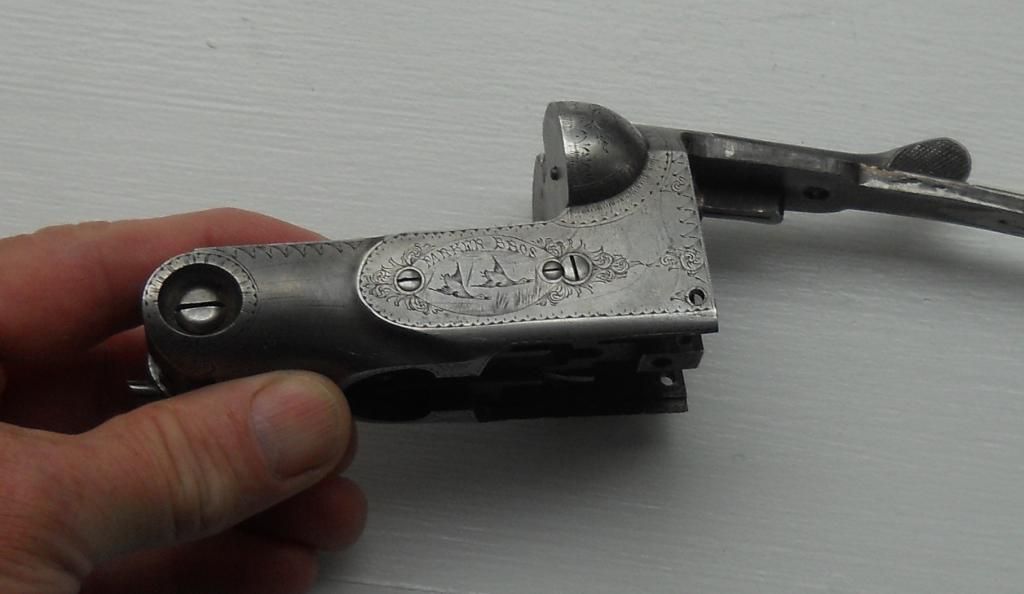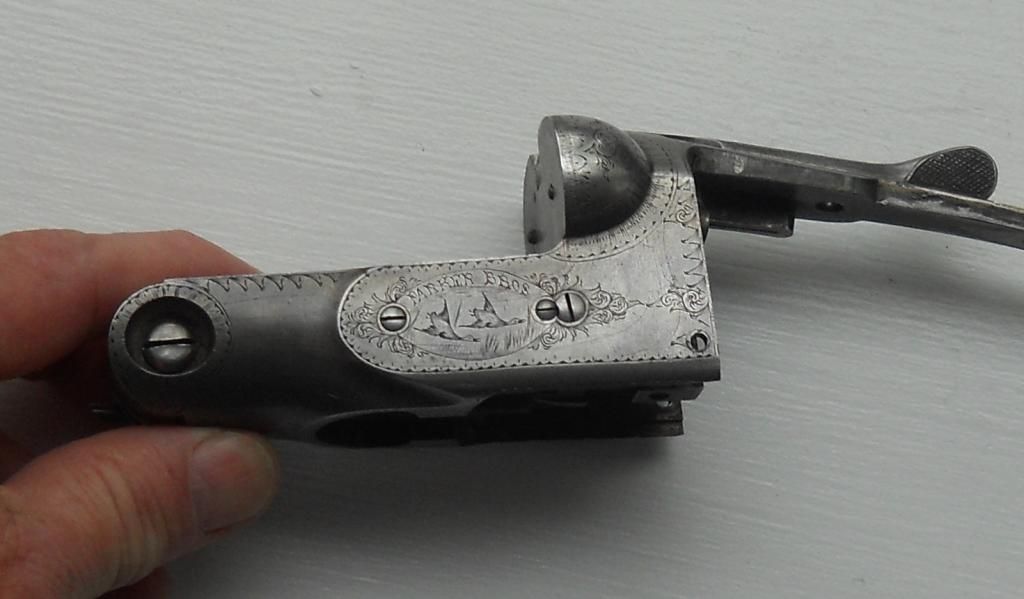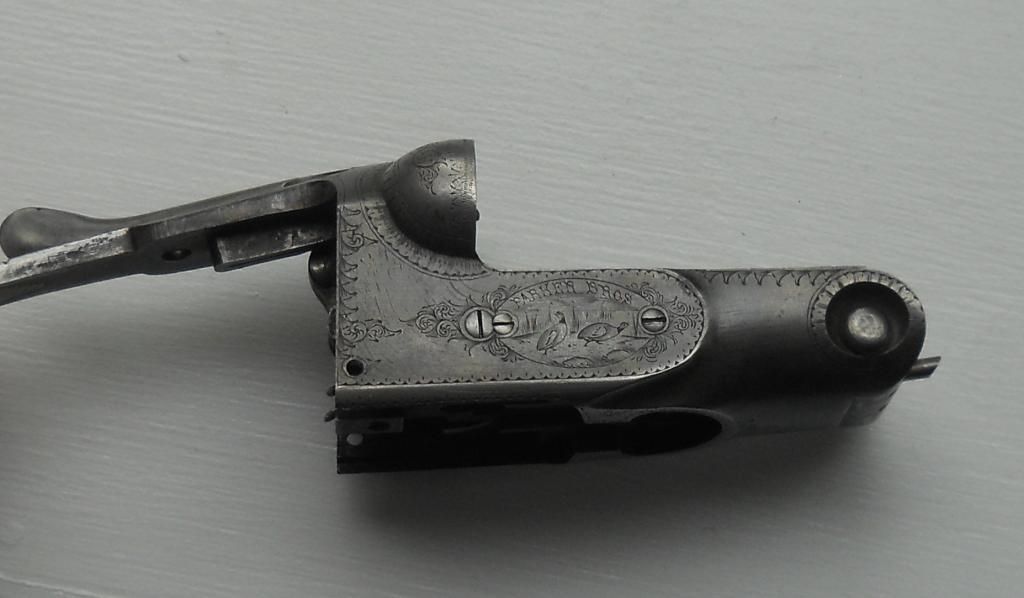Greetings all,
I noticed a comment that Kirby Hoyt made regarding one of the guns on his site which really has my interest peaked! He mentions that the lines on the bottom of an action are not scratches but are forging marks which often appear on guns more than 100 years old. See here -
http://www.vintagedoubles.com/catalog/?sort=2&process=fullview&gunID=2236I have never heard this before but it would make sense as you often tend to see these marks on older hammerguns with smooth action bottoms.
The picture below is from a gun built in 1899 and I had assumed that these similar lines were scratches, but they donít really look like scratches upon close inspection. It would solve a puzzling question if this is indeed the case.
Can anyone verify this? Somehow, I have never heard or seen any mention of this before.
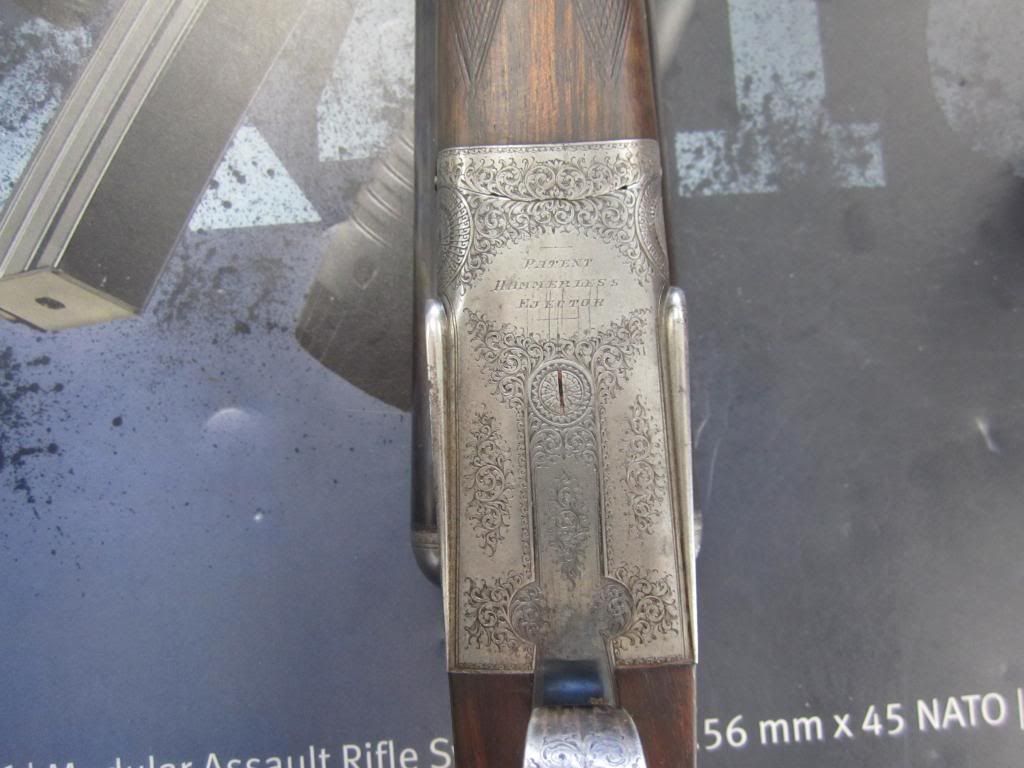
BG,
I've seen cracks, voids, inclusions, and various discolorations in forgings. A lot of stuff is possible. But looking at that picture isn't enough for me to be able to figure out what it is. They just look like scratches to me.
Hi Chuck,
I will try to take a macro of the bottom of the action and perhaps that will help determine what the lines are.
Could those in the picture be scratches after all. They seem to have a similar color as the engraving. Interesting.
Absolutely correct and that is what they look like in the picture above. They are quite commonly seen on early Winchester lever actions as well. Knowledgeable collectors usually request that they be preserved when restoring. Commonly mistaken as scratches.
Best, Dan
I agree with cgs. Having collected older 94 Winchesters the lines are seen quite often. I have picked up a few at a discount because of them. They are correct from my HUMBLE point of view.
Early in my collecting career I traded for an early Parker 20 ga. One of the earliest Parker VH 20s. It's frame had those lines and I thought the gun might be defective. That was when $800 was a lot of money for a gun like that.
It'd be interesting to do some NDI on guns with these. I wonder if they're "coldlaps" .
All of my Model 1893 Marlins had lines like that, too.
Grain lines in the metal from the original forging . You see a lot in wrought iron work .Not a lot you can do about them with out polishing them out and by that I mean file rather than mop. Even then there is a percentage that will probably always show .
All old ladies have wrinkle or two .
I'm with gunman...in my experience some of those lines can go quite deep and you would never be able to file them away.
Grain lines in the metal from the original forging . You see a lot in wrought iron work .Not a lot you can do about them with out polishing them out and by that I mean file rather than mop. Even then there is a percentage that will probably always show .
All old ladies have wrinkle or two .
I'm not an metallurgist, but I believe we have a member or two that is. Possibly Dick Dup. He can probably give a technical explanation of the possible causes of these lines.
I know there are many different defects that can occur in forgings.
Those look too fine to be cold laps, but hard to be positive from a pic.
I think many folks have seen wrought iron inclusions (silicates?), but there's usually a 'grain' to it. I see lines that cross near ninety degrees to each other, might be hard to do that by forging metal without some distortion.
I'd still guess, in that particular picture, maybe those are rough filing marks that telegraphed through the finish because they weren't seen or the part was taken to some final dimension.
I believe it is a typical by-product of the steel manufacturing technique for small batches production in the late 1800's. Prior to widespread adoption of Bessemer's Converter and crucible steels a different technique was used. It was known as fa-g-g-oting (strange but true) Iron rods were drawn from pure puddled iron. @ 1/2" diameter. The rods were then case hardened by cementation method for @ 24 hrs to infuse carbon into the iron.After case hardening they where cleaned off, fluxed and bound together into a bundle(fa--ot) of 10-20 rods. then heated to white heat and pounded together. The end result was a billet of steel. Incidentally the Birmingham gun quarter was/is bordered by Steelhouse Lane which reflects a business that performed this method.The marks one sees are the boundaries between rods. As a production technique it disappeared around the year 1900.
Thank you for your explanation Hugh. After seeing many examples of this over many years, yours is the first detailed description of what was the cause that I have read. Terry
Are they an indication of weakening structure as has been suggested to me by one of my gunmaker friends?
Blue Grouse, You'll find a good answer to your question in a little known, but very interesting book: Fighting Iron, by Art Cogan.
Sorry, I don't have it on hands now, so I can't tell the exact page.
Check old Highwalls. Most all of them have forging lines.
If what Hugh Lomas says is true, and it does sound very plausible, wouldn't it be fairly easy to confirm by draw filing and then rust bluing one of these actions by the same process used to blue or brown Damascus barrels? Since the case hardening infusion of carbon into the pure iron rods would only be a few thousandths thick, subsequent hammer welding and forging of the fagg*t would not give a homogenous steel product, but something more akin to an action forged of layers of iron and steel, i.e. Damascus. Rust bluing followed by etching would leave the high carbon areas blue/black while the pure iron areas would be etched white.
Gents,
Thanks for all of the input! This is exactly why this BB is such a superb venue for the exchange of information. It would have taken me years to get to the bottom of this otherwise.
Here is a macro of the action which shows more detail. Click on the picture and enlarge it for more detail. I took a few images and this was the one which shows the lines the best. If you look closely, the lines do not appear to be scratches as scratches would drag some metal into the engraving in the direction of the scratch (or so I think).
I think the lines show some personality on the old girl and I'm glad to know that these are natural and not some external damage to the gun.
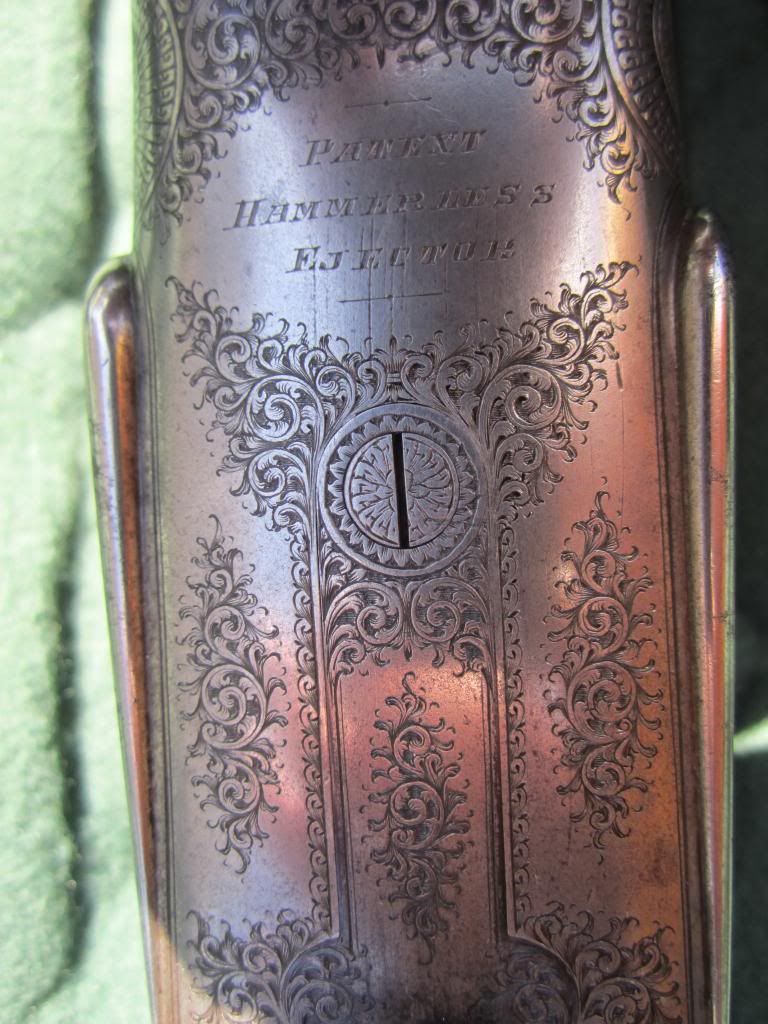
Great picture, I can see the crossing lines are very different from what I thought. I'd also suspect the lines were there before the engraving was done. Just my opinion, but your link of the Holland & Holland seems to be a different effect from your new picture.
I think the link is an excellent example of what others are describing. Possibly, wrought iron slag inclusions appearing as lengthwise irregular grain with signs showing through the whole piece.
I think it's possible to put a fine finish on wrought iron. If those slag lines are there, I wonder if they might be revealed by a mild acid etch such as years sweat from normal handling. I wonder if that H & H had most of its lines show about where it balances or where it cradles when it's broken open. Just wondering, thanks for the topic.
If they were forging lines don't you think a reputable maker such as a Holland & Holland would polish them out ?
What I see are scratches. I've saw the same type on a few old muzzle loaders only difference they were in the wood just forward of the trigger loop.
Possibly made from pushing or holding down wire fencing when crossing.
I have seen old guns with something like wood grain that I don't doubt are a result of the forging process.
Like jOe I think those marks in the picture are scratches.
Best,
Mike
Joe, it would have been polished when new . That's the point it's old and time and environment have taken its toll . Take for example an old Damascus barrel that has never been touched and not particularly well card for and you will see that the surface has been "etched" away on the softer irons . I am not a metallurgist but I have seen many guns with similar marks and I do know if you pickle an old action to remove rust you often see a whole raft of similar lines that need to be struck out prior to re engraving or re hardening . I do not believe these are scratches.
Boy, this is a tough one.
Could striations occur during forging? Absolutely. Could these parallel lines have been created by the drawing of the bar, pre forging? Absolutely. They aren't exclusive to each other.
But why show up years after initial finishing?
Differential corrosion.
That would suggest that a mild acid would reveal their continuity.
Discontinuous? Probably scratches.
Those crossing lines above and below the "Patent Hammerless Ejector" look to me to be intentionally engraved ledger lines or whatever they're called. Both are perfect and have a dot in the middle.
The longitudinal lines are what I believe the subject of this thread is about. After Hugh provided the explanation of the hand forging process of folding over bar stock, I can see where there may be what amounts to a linear inclusion of scale from folding over the bar multiple times.
The forging on guns of this period would almost certainly have been drop forged not blacksmith forged . Companies like Victoria Forgings in the "Black Country " did work for many Birmingham makers and indeed produced " standard" forgings or stampings of many parts . Webley had there barrel blanks forged out of billets as they did their actions and forend irons . Occasionally a forging fault would show up on machining in the form of black lines.
Thank you for revisiting the topic gunman. Would you happen to have any thought as to why the appearance of the longitudinal lines are so different from the link on the first post and closeup of this subject gun that Blue Grouse added.
That link H&H really looks like how stringy grain wrought iron might look. The lines in the picture above look a lot like the crossing line engraving that Chuck pointed out.
I ran my fingernail across the picture on the computer screen and did not feel any scratches. I'd like to run my fingernail across these longitudinal marks on the gun itself to see if they have depth. I think if this was due to corrosion, even from sweat, it would have affected the engraving too.
I have seen a lot of guns that have actual scratches in this area which comes from holding down fence wires while crossing, as jOe says. I see the same damage on the forearm wood on some guns. It seems to be a regional thing. In my neck of the woods, most guys held down the top strand of barbed wire with the buttplate, and we see damage to that part. If the wire on an electric fence slips while you are crossing, the result can be shocking indeed. I saw a buddy do just that while crossing an electric fence with his father-in-laws .222 Rem. while we were groundhog hunting. When the wire sprang back up to his crotch, he reflexively flung the gun about 15 yards back into the pasture. That was 30 years ago, but I still chuckle when I think about it. I think that's why they recommend opening the action while crossing a fence.
Gentleman,as Gunman said these lines are found on guns from pre-1900, and because of that,more commonly on hammerguns.Also on guns that have had their C.C.hardening worn off and likely been subjected to a liberal amount of blood, sweat, and tears, which I assume has allowed a certain amount of corrosion to act on the material in the fold lines that Hugh referred to.These lines are observed on guns by all the makers including Purdeys etc. A product of the action forging methods of that time period.
Early Savage 1899's show these "flow" marks in the receivers that are in no way scratches. They have been attributed to the forging process.
This is a minty 1899 with "flow marks" in the reciever. I suspect these are also what are showing up in early shotgun receivers.

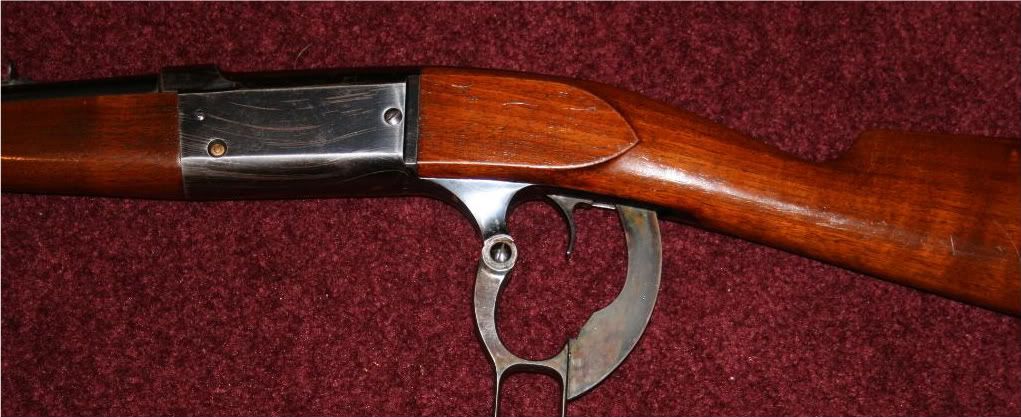
Romac, thanks for posting these photos. I engraved an old Martini action a couple of years ago and when I had it blued and then stripped the blue on the scene area for a grey finish, differential colored lines just like that appeared where they had not been noticable before when in the polished state. Really had me baffled as to where they could have come from.
I've several guns that exhibit this feature and have seen many more. I had assumed scratches, but had trouble reconciling just how all these guns got the same stratches. I'd toyed with the idea of some common "brushing" technique, but the engraving did not bear this out. So, I'm delighted for a sensible explaination. I'll have a look under a microscope and see if I find anything worthy of reporting.
DDA
Maxm: You nailed it - Fighting Iron by Art Gogan.
Page 100 with illustrations on Page 101.
Quoting from Page 100 - "The distortion of the metal grains in the hot forging process is evident as an elongation of the grains along the axes that are parallel to the path of the plastic-like flow of the hot metal under the influence of pressure applied by the hammer or the die(s). These severely elongated grains result in residual stress gradients between the distorted grains and their boundaries or interfaces with adjacent grains. Because some corrosion mechanisms display differences in the corrosion rate that are attributable to the presence of stress, older forgings that have experienced slow, uniform surface corrosion will frequently exhibit a pronounced visibility of the "forging flow lines" as the corrosion highlights the elongated granular structure of the forging (see photos on right-hand page). These gently curving, striated surface features will often be observed on the well aged and worn ferrous forgings commonly used for firearm frames and receivers of the last half of the 19th century and first quarter of the 20th centuries. Unquote.
Ian
Thanks for once again dispelling the myths that surround the lines seen on some old gun actions. The path of these lines also indicates that the Gun makers and forge masters of the period understood the importance of correct grain flow to maximising ultimate strength of the action. For this reason todays engineers designing forged components specify by means of a diagram the grain flow they require .
Whist some Birmingham gun makers did produce small forgings for sporting guns. It is very likely that because of the size of the action body and the corresponding large capacity of the forging machines required, that this work would have been outsourced to specialist forge shops operating in surrounding Black Country towns,such as Hales Owen and Darlaston.
We tend to forget that the majority of Gun Barrels and gun locks used by the Birmingham Trade were in fact outsourced to business located in the Black Country towns.
Birmingham producers of military weapons for example; B.S.A, Webley and Scott and to some extent Greener did producer high volume forgings and gun barrels in house.
I never knew built up stress would cause the lines. Maybe one of the various stress relief heat treatment strategies should be done prior to removing any metal to stop the process rather than chasing something that could go through and through.
I have several pre-1900 Parkers with these lines. In fact, the process of drop-forging or "bulldozing" the billet into the desired shape of the raw frame block has caused a very visible uniform curve of these lines along the side of the frame up into the standing breech. If I could figure out how to post pictures here I would do it. If someone cares to give me their email address I will send him pictures and he can post them. I have never thought they were anything other than imperfections in the billet and the fact that they curve with the shape of the frame leaves no doubt of their origin.
dsromig@aol.com
Dean
Thanks Mike for posting the pictures. They don't show quite as clearly as I had hoped but are still relatively easy to see. By the way the horizontal lines curve to the vertical standing breech it is very easy to imagine the drop-forging process that formed the shape of the frame block.
I edited DAM16SXS pictures:
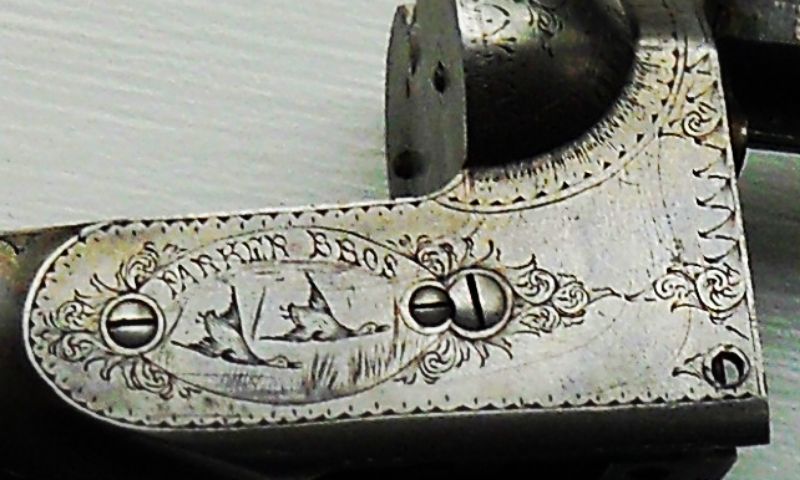
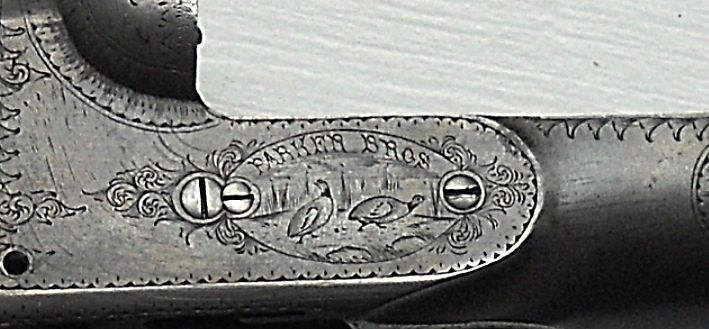
Thanks Mike - much easier now to see the curvature of the billet imperfection lines.
Very interesting...they show well!
I found a glossary of forgings at
https://www.forging.org/glossary-forging-termsFlow lines ó Patterns in a forging resulting from the elongation of nonhomogeneous constituents and the grain structure of the material in the direction of working during forging; usually revealed by macroetching. See also Grain Flow. I think today "nonhomogenous" means "dirty" metal. Modern chromoly alloys and specialty steels are often vacuum-arc-electro melt and often vacuum-arc-electro re-melt (more than one melt, often with a trimming of the ends of the ingots to remove impurities prior to remelt), which efficiently homogenizes any intended constituents and removes unintended constituents/impurites.
Some reference info.
http://en.wikipedia.org/wiki/Electric_arc_furnacehttp://en.wikipedia.org/wiki/Vacuum_arc_remelting
Chuck, I agree with youabout today's metals. I think the definitions you gave would equally apply to a situation of unequal carbon content of plain carbon steel made as described above. The case on the rods would be of higher carbon content than the core. Unless literally melted, this difference in carbon content would be retained during the forging process. So, what we are seeing is sort of a steel-steel damascus of very simple pattern. Had the rods been twisted and rolled out per pattern welded barrels we would see a much more complex pattern of these lines.
DDA
If I'm not mistaken, these actions were made of wrought iron. A thin layer of carbon may have been added by case hardening, but I don't believe wrought iron had any carbon in it to make it a steel. I believe wrought has a stringy pattern just on its own.
I think the finer the lines that show, chances are the more the wrought was forged out to reduce the effect those lines may have on the integrity of the final part. I suspect the difference in appearance is from components other than carbon. Chances are, forging different carbon content steels together ends up evening the carbon content between the two.
I just had a look at the bottom of the action of a Holloway SLE Pigeon (not a best work gun, but no slouch either) of 1890ish vintage. I has these "stripes" clearly visible and easily mistaken for scratches. The look I took included a 2X to 12X folding pocket glass made it clear that they are not scratches of cracks. A 30X pocket microscope was ver interesting. Along the "stripes I found several areas of both black and white inclusion; very narrow/thin bands of inclusion, but definitely inclusion of something not steel, things that would qualify for Chuck's dirty steel.
I'll look at a few more guns and see if I get similar findings. Photos --- mmmm, I dunnno, we will see. Most interesting!!
DDA
craigd
Following the patenting of the Bessemer process in the U.K. in 1856 which resulted in low cost conversion of pig iron into steel.Bessemer steel rapidly became the prime source for steel as used in gun barrels, locomotive rail, gun body actions etc.
The Bessemer process was licenced into the U.S.A.by the early 1860,s.
The steel used in both American and British gun body actions during this era would have been forged from billets of steel made by the Bessemer process. Prior to improvements to the Bessemer process the refining of the steel was not always perfect.This is the reason we some times see the forging lines in the action of both British and American guns made in the 1860-1900 time frame.
If I'm not mistaken, these actions were made of wrought iron. A thin layer of carbon may have been added by case hardening, but I don't believe wrought iron had any carbon in it to make it a steel. I believe wrought has a stringy pattern just on its own.
I think the finer the lines that show, chances are the more the wrought was forged out to reduce the effect those lines may have on the integrity of the final part. I suspect the difference in appearance is from components other than carbon. Chances are, forging different carbon content steels together ends up evening the carbon content between the two.
Craig,
Wrought iron is not a material that is typically compatible with forging as it can have a tendency to crack when hot forged. It was as close to pure iron as was available at the time (.10-.25%). I think what we're looking at with these actions is early Bessemer steel with contaminants or constituents that weren't homogenized.
Sometimes I take for granted the knowledge and scholarship that the members of this board can bring to bear on a technical topic. Thanks to all of you who contribute to such discussions as this one.





